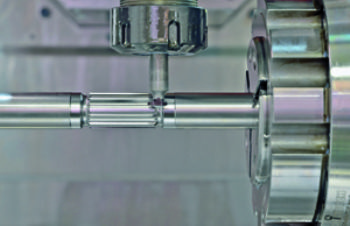
Westwind Air Bearings Ltd, the Dorset-based high-speed drill spindle specialist, has been able to bring back to the UK the manufacture of key components that had been previously out-sourced to sub-contractors in China.
Reliable minimally manned machining, including periods of ‘lights out’ running, has been the cornerstone of this initiative’s success. This was achieved through the use of modern machining technology that relies on high-performance tooling, including Type 306 flute-milling tooling supplied by Ringwood-based Horn Cutting Tools Ltd (www.phorn.co.uk).
This is one of a number of successful Horn applications at Westwind’s Holton Heath factory. As well as providing tooling for the spindle project, Horn recently developed a long-reach Supermini Type 105 for Westwind; this is used for internal boring on small-diameter collets. As well as internal boring within a 2.0mm-diameter entry bore, the delicate looking 19mm-long tool (35mm including the clamping element) also machines an internal under-cut as part of a sliding-head machining operation.
Westwind began by making air-driven dentist’s drills during the 1960s. Today, it is a leading manufacturer of drill spindles used to produce minute holes in printed circuit boards. PCBs are used in billions of devices, and demand for Westwind’s products is high. The firm currently makes a range of electrically driven spindles that rotate at speeds from 180,000rev/min to 400,000rev/min (necessary for drilling holes with diameters that are often measured in thousandths of an inch).
Near-friction-less bearings

The only means available of supporting spindles running at such high speeds is by ‘floating’ the journal bearing surfaces of the spindles in air bushes to provide a near-friction-less system. For this to function, the dynamic balance of the rotating assembly needs to be as close to perfection as available manufacturing technology will allow. A critical feature of the spindle component is a series of axial flutes on the outer diameter; these are ‘filled’ with copper in subsequent operation to create the armature of a fully balanced integrated motor drive.
Westwind production engineer Dave Tyler says: “The true test of the machining process rests on the flute profiles being ‘spot on’ when referenced to a gun-drilled hole through the spindle centre — and achieving the required cycle time. When we were developing the current machining method, we had a target time of 90sec or less for that part of the cycle; we also needed perfect profiles, no burrs and a very-high-quality as-machined finish.”
The spindles are machined from heat-treatable stainless steel; batch quantities are in multiples of 15, and there are six variations of spline profile across the range. Previously, the components had been made in multiple stages, starting with individual billets; they were initially gun-drilled, followed by profiling on a CNC lathe and milling of the splines. High labour costs led to production being sub-contracted to China during the early part of the last decade. However rising component costs from China — plus a desire to increase flexibility and have greater control over quality — initiated the development of an improved manufacturing process that would allow the work to be carried out cost-effectively in the UK.
Single-machine working

Key to the success of this project has been the development of a fully integrated machining facility, in which all steps are completed on a single bar-fed machine in a continuous operation that combines the benefits of single set-up production and minimal manning. The tool capacity and control facilities offered by the machine — including tool monitoring — are such that tooling for all the variants, along with ‘sister’ tooling, is available. As a result, multiple spindle types can be produced sequentially, provided that they are based on the same bar diameter. When necessary, change-over to a different bar diameter takes 30min.
The first operation is to machine the exterior of the bar to generate the basic external profile, which includes a flange at one end. The central bore is then gun-drilled (to a concentricity that is better than 0.001mm), and the part-machined component is parted off at the main spindle end while supported in the counter-spindle.
A probe is then used to establish a reference point — based on the gun-drilled hole — for an interpolative milling operation that produces a 60deg included-angle taper at the end of the bore. The taper locates on a temporary centre that is machined on the nose of the bar in the main spindle; this provides support between centres for the part-machined component during the flute-milling cycle.
Depending on the spindle variant being produced, the overall cycle time can be up to 25min. “Accurately machined flutes finished to a very high standard are the key requirement, alongside the reliability and performance of the tooling,” says Mr Tyler. “We have a long-standing relationship with Horn, and we were confident that they could provide a satisfactory solution.”
Following milling trials using a standard full-radius insert and a machining centre equipped with a fourth axis, Horn suggested a ‘special’ Type 306 triple-edged milling insert as the most likely solution. Further trials using custom-ground cutting-edge profiles established the basic cutting data and confirmed the viability of this solution. The insert material for this job is grade AS; the inserts also have an AlTiN heat-resistant coating, developed for grooving and finishing materials such as stainless steel at high cutting speeds. The inserts are providing ‘exceptional’ service life and support Westwind’s requirement for minimally manned operation including ‘lights out’ working.
In conclusion, Mr Tyler says: “We ultimately settled on a roughing and finishing route based on using a common tool. This achieved the cycle time that we wanted. As a result, the Horn Type 306 meets the productivity, quality and tool-life targets that we required, producing high-quality components that are ready to go straight on to the next stage of manufacture.”